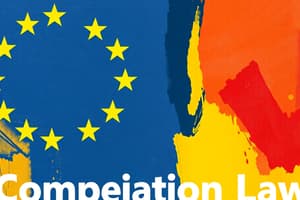Podcast
Questions and Answers
What is the primary purpose of compulsory licensing?
What is the primary purpose of compulsory licensing?
- To allow patent holders to sell their inventions without restrictions
- To enable governments to sell patented inventions to other countries
- To limit the duration of patent protection periods
- To prevent monopolistic practices harmful to public welfare (correct)
Which of the following statements about anti-competitive effects in licensing arrangements is true?
Which of the following statements about anti-competitive effects in licensing arrangements is true?
- Anti-competitive effects must be assessed on a case-by-case basis. (correct)
- Anti-competitive effects can only occur in purely cartelizing agreements.
- All licensing agreements are considered anti-competitive.
- Licensing arrangements are always pro-competitive.
What requirement must be met before invoking compulsory licensing in non-urgent cases?
What requirement must be met before invoking compulsory licensing in non-urgent cases?
- Patent holders must accept lower remuneration.
- A national emergency must be declared.
- All patent holders must agree to the licensing.
- Efforts to obtain authorization on reasonable commercial terms must be made. (correct)
What must patent holders receive when their invention is subjected to compulsory licensing?
What must patent holders receive when their invention is subjected to compulsory licensing?
How does compulsory licensing address anti-competitive practices?
How does compulsory licensing address anti-competitive practices?
What is a primary condition under which countries may share non-confidential information during consultations?
What is a primary condition under which countries may share non-confidential information during consultations?
What measures may countries adopt in formulating or amending their laws and regulations regarding public health?
What measures may countries adopt in formulating or amending their laws and regulations regarding public health?
What action should be taken to address the harmful effects of restrictive business practices related to trademarks?
What action should be taken to address the harmful effects of restrictive business practices related to trademarks?
Which of the following is considered a restrictive practice as per the provided content?
Which of the following is considered a restrictive practice as per the provided content?
What are horizontal market division agreements?
What are horizontal market division agreements?
What is a tying arrangement in the context of trademark licensing?
What is a tying arrangement in the context of trademark licensing?
What is a recommended government measure to combat anti-competitive practices?
What is a recommended government measure to combat anti-competitive practices?
What is the intended purpose of preventing the abuse of intellectual property rights?
What is the intended purpose of preventing the abuse of intellectual property rights?
Which of the following is considered an anti-competitive practice?
Which of the following is considered an anti-competitive practice?
What is a benefit of the Madrid System for international trademark filing?
What is a benefit of the Madrid System for international trademark filing?
Under Article 40 of the TRIPS Agreement, what can member countries do to address anti-competitive licensing practices?
Under Article 40 of the TRIPS Agreement, what can member countries do to address anti-competitive licensing practices?
Which of the following represents a consequence of abusive exclusionary conduct by a dominant company?
Which of the following represents a consequence of abusive exclusionary conduct by a dominant company?
What is meant by 'evergreening of patents' in the context of anti-competitive practices?
What is meant by 'evergreening of patents' in the context of anti-competitive practices?
Parallel importation refers to which practice?
Parallel importation refers to which practice?
Which of the following is NOT a recognized symptom of anti-competitive practices?
Which of the following is NOT a recognized symptom of anti-competitive practices?
What is an essential feature of the measures that member countries can adopt against anti-competitive licensing practices?
What is an essential feature of the measures that member countries can adopt against anti-competitive licensing practices?
Study Notes
Anti-Competitive Practices
- Abusive exclusionary conduct by dominant firms restricts market competition.
- Refusal to provide goods or grant licenses under fair market conditions is a common issue.
- Excessive pricing practices harm consumer access to goods.
- Vertical arrangements between suppliers and distributors can distort competition.
- Evergreening of patents prolongs protection beyond original intent, as seen in Novartis vs UOI.
- Parallel importation issues highlighted in the case of Kapil Wadhwa vs Samsung.
Advantages of International Filing
- The Madrid System facilitates global trademark protection through a single application in one language and currency.
- Trademark management is centralized, allowing for efficient expansion into new markets.
- Represents over 80% of world trade, making it a widely recognized mechanism for trademark registration.
- Cost-effective; eliminates the need for multiple applications and related translation costs.
Minimizing Restrictive Practices
- Article 40 of the TRIPS Agreement highlights the adverse effects of certain licensing practices on competition and trade.
- Countries can implement measures to control anti-competitive practices in IP licensing aligned with TRIPS provisions.
- Consultations between member countries can occur if anti-competitive actions are suspected, promoting transparency and information sharing.
- Reciprocal consultations allow countries facing anti-competitive practices access to similar dialogue opportunities.
TRIPS Agreement Principles
- Member countries can adopt protective measures for public health and interests in crucial economic sectors, in line with TRIPS provisions.
- Efforts to prevent IP rights abuse must align with TRIPS to ensure fair trade and technology transfer.
OECD IP Recommendations
- Harmful effects of restrictive business practices regarding trademarks should be minimized while ensuring trademark owners' rights.
- Import restrictions on legitimately marked products should be eliminated to prevent artificially high prices and anti-competitive behavior.
- Horizontal market division agreements among competitors are prohibited, as they inhibit competition.
- Trademark-related sales restraints and tying arrangements are also seen as restrictive practices that hinder fair trade.
- Price maintenance agreements can create an uncompetitive environment, limiting market dynamics.
Compulsory Licensing under TRIPS
- Compulsory licensing allows governments to use patented inventions without the holder's consent, addressing public welfare concerns.
- This mechanism is crucial during national emergencies or for essential goods and medications.
- It balances patent holders’ interests with public needs, ensuring reasonable commercial terms are sought first.
- Compulsory licensing promotes fairness and enhances innovation and technology transfer while allowing adequate remuneration for patent holders.
Studying That Suits You
Use AI to generate personalized quizzes and flashcards to suit your learning preferences.
Related Documents
Description
Explore the dynamics of anti-competitive practices and the advantages of international trademark filing in this comprehensive quiz. Understand the impact of dominant firms on market competition and the benefits of the Madrid System for global trademark protection. Test your knowledge on these critical legal concepts and cases.




